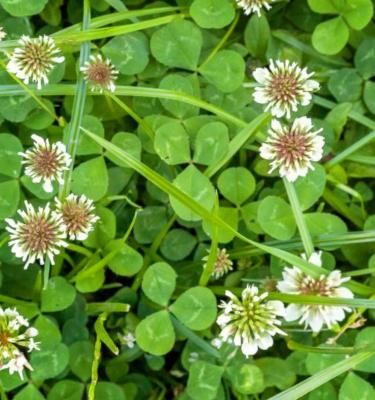

How to Identify & Get Rid of Clover Weeds
Clover is often seen in gardens in Australia, and is commonly regarded as a weed, as it appears where it is not wanted. It is a nuisance in lawns and can spread to flowerbeds. It is beneficial to pollinators, but here we look at how to manage clover when it becomes a problem in the garden.
A single clover plant can spread to up to a metre wide, covering a very large area with a mat of creeping stems. The plants can put down more roots wherever the stem touches the ground, creating a dense and perennial green ground cover which can be hard to kill off.
Clover will withstand heavy and repeated cutting or grazing, as well as poor conditions, making it a persistent and tough weed. Unfortunately, these robust qualities mean that it is deliberately added to some commercial grass seed mixes, where it can help to establish a lawn in a challenging environment. Clover can also present as a weed when introduced to the garden from pots of other plants, wind, birds, or from existing clover plants nearby.
The presence of clover weed in a lawn is an important indicator of the health of the grass. Like other plants in the pea family, clover thrives in soil that has low levels of nitrogen, so it can point to an imbalance of nutrients in the lawn.
How to identify clover
Clover is a perennial, presenting itself all year round as a dense, low-growing mat of foliage.
The botanical name for the genus clover, Trifolium spp., provides a useful clue as to how to identify it. ‘Tri’ derives from the Latin ‘tres’, meaning three, and ‘folium’ from ‘leaf’. So, as you might expect, clover weeds usually have three lobed leaves. These lobes are actually called ‘leaflets’. Exceptionally, four-leaf clovers are discovered, but these are rare and so count yourself very lucky if you find one!
On close inspection, the edge of each leaflet is lightly serrated, and there is an easy to see vein along the middle which can be traced back to the stem. There is also often a pale green or white flattened ‘v’ shape on the surface of the leaflet.
Clover weed generally flowers from winter through to the summer. The flower stalks are upright, and the flower heads are densely formed. The flowers are white, pale pink, red, yellow, or purple.
Types of clover weed
There are over 300 known types of clover, also known as trefoil. The most common ones found in Australia are:
Trifolium repens (White clover, Dutch clover, and Ladino clover)
- White or creamy-pink flowers which are up to 20cm across. Repens means creeping, and it will be found spreading above the soil surface with stiff stolons, putting down roots wherever it can to take advantage of gaps in the grass.
Trifolium pratense (Red clover)
- Attractive purple-red flower heads which can reach up to 3cm across. The plant can reach up to 50cm in height and has a strong tap root.
Trifolium fragiferum (Strawberry clover)
- Delicate pinkish coloured flower heads which are approximately 1cm across. The flowers turn into quite solid seed heads, resembling a strawberry or raspberry.
Trifolium dubium (Shamrock, lesser trefoil, suckling clover).
- An annual with small yellow flowers of about 1cm across. Small rounded leaflets, and a deep tap root.
Other related plants in the same ‘Fabaceae’ family as the clovers listed above include:
- Medicago polymorpha (Burr medic or bur clover). Distinguished from other clovers by the small coiled fruits, also referred to as ‘prickles’ or ‘burrs’, which appear after the yellow flowers have finished blooming.
- Melilotus spp. (Sweet clover). A tall growing plant which can reach over a metre in height, it has a long taproot and a yellow or white flower.
- Lotus corniculatus (bird’s foot trefoil, eggs and bacon, ground honeysuckle). Five leaflets, each narrow and pointed. It has yellow flowers, sometimes with orange markings.
All the above plant species are sometimes mistakenly identified as Oxalis spp. The three-part leaves give Oxalis a similar appearance to trefoils, but the flowers are very different, always having five petals.
How does clover weed affect your lawn?
Clover weed displaces lawn grass as it competes with it, suffocating grass and taking nutrients and water. Uncontrolled, the weed will spread further over lawned areas, taking advantage of weakening grass.
These broadleaved weeds can shoot up flower heads that are out of keeping with an immaculate lawn sward.
Research also suggests that clover can host the destructive red legged earth mite and light brown apple moth. The burrs or prickles produced by Medicago polymorpha, can cling to and irritate pets (as well as helping to spread the weed further).
How to get rid of lawn clover
The first thing to consider if you find clover in your lawn, is whether there is an imbalance of nutrients in the soil. Clover can indicate that there is not enough nitrogen, which means that the grass cannot thrive to its full potential. If you suspect this might be the case, apply a lawn fertiliser which is high in nitrogen, such as Scotts Lawn Builder™ All Purpose Slow Release Lawn Fertiliser.
Clover is an opportunistic weed which will take root in bare patches of lawn. To get ride of clover weed, reduce the space available for it to do this by using a product like Scotts Lawn Builder™ Lawn Thickener Lawn Seed to encourage thick, healthy grass.
A lawn weedkiller can get rid of most species of clover, such as white and red clovers. Make sure to choose a chemical which will not discriminate lawn grass from other perennials. Buffalo, kikuyu and other lawn types can be damaged by the wrong weedkiller, so find the right selective herbicide and use at the frequency and quantity suggested by the manufacturer.
Mow Lotus corniculatus before it flowers and has a chance to produce seed. Hand-weeding this species is difficult, as often the plant will break before the entire root can be removed, so it will simply regrow. A selective weedkiller can be useful.
Trifolium dubium and Medicago polymorpha respond better to an organic approach rather than weedkiller. Rake Trifolium dubnium to pull the plants into an upright position, and then mow. Remove the shallow rooted Medicago polymorpha by hand, but do not compost them, as the burrs and prickles will germinate to produce new plants.
Whichever approach to killing clover weed is taken, try to do it after the winter, when plants are putting on new growth.
Clover can hugely benefit the garden by attracting pollinators, especially bumblebees and honeybees. It is a very important source of nectar to them, so only control it if it really has become a nuisance weed. Clovers can be hand weeded, using a grubber or small knife, where individual plants appear in flowers borders. If it is not causing an obvious problem in the flower bed, leave it for wildlife.
How to prevent clover weeds on lawn
Good lawn maintenance will help to keep the grass in optimum health and prevent the growth of clover.
Mow regularly to remove flowers before they are able to set seed. Rake the lawn first to bring up stems and stolons which the mower can then cut. If the clover has flowered recently, make sure to collect the cuttings so that seeds are not dispersed again.
Aerate and feed the lawn to help the grass thrive. Use a high-nitrogen fertiliser such as Scotts Lawn Builder™ Premium Liquid Lawn Fertiliser or Scotts Lawn Builder™ Premium Slow Release Lawn Fertiliser.
If using green manures elsewhere in the garden or grass seed mixes to repair the lawn, carefully check the label for the presence of clover. After working to remove clover, it would be a shame to unwittingly reintroduce it!












